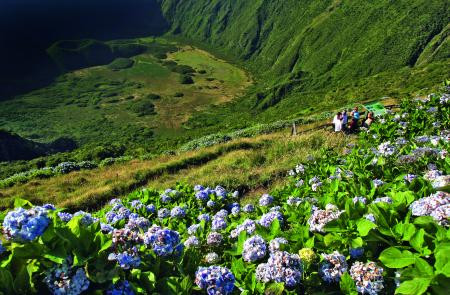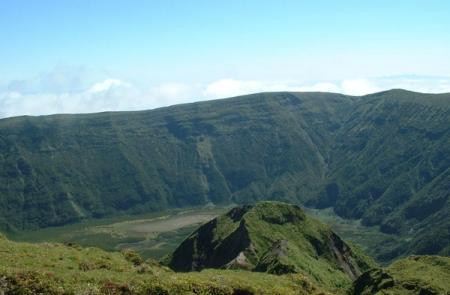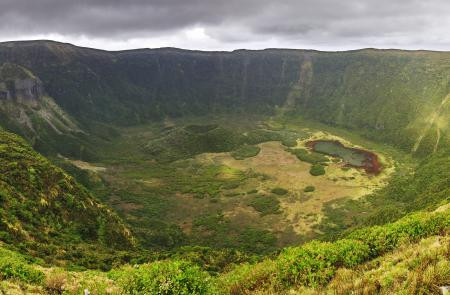Walking Tour: Caldeira Descent
About the Experience
At an altitude of 1000m, we invite you to descend 400m to the crater of a dormant volcano. This Caldeira, covered by luxuriant Macaronesian Laurel Forest vegetation has collapsed throughout its different eruptions, whose most recent one occurred only 1200 years ago, covering 70% of the island with pumice stone.
The trail is quite technical, demanding on hips and knees. It follows a rock depression caused by water erosion, with several sections with thin passages, requiring crouching to avoid the natural plants, becoming more demanding the ascent.
Caldeira Descent Further. Details on Vegetation Aspects
The 2km wide Natural Reserve of Caldeira was first protected in 1800's to forbid the extraction of fire wood. In 1972 it was one of the first nature reserves to be established in the Azores, currently referred as a plant sanctuary - it is in fact a place to enjoy the Azorean floral endemism at its best. So much care should be taken regarding the destruction of plants and pollution of the location.
The caldeira border comprises the highest point in Faial - Cabeço Gordo at 1043 m dominated by alpine vegetation, characterized by mosses Sphagnum spp., Juncus sp., Azores Heather (Erica azorica), and flowering Daboecia azorica, Leontodon filli, Tolpis azorica, Hypericum foliosum, among other species. These define the first phase of the descent and may be seen through the first sections.
The trail follows a rock depression caused by water erosion, with several sections with thin passages, requiring crouching to avoid the strong branches of Azorean heather that extends with great expression through the descent.
After descending ca. 100m in altitude, the landscape then changes to a rare wood dominated by the Azorean Juniper J. brevifolia, with several trees of large size covered in a great variety of mosses. This is the only angiospermic from the Macaronesian Laurel Forest. Look out on the Juniper for the epiphyte Arceuthobium azoricum, and see if Rubia agustinhoi doesn't get a free ride on your back. Myrsine africana and several fetus such as Culcita macrocarpa or Polypodium azoricum will compose this pre-historic scenario.
As the descent continues, the landscape will change again to species characteristic of the mid-altitude forest, particularly Azorean holy Ilex perardo, Azorean laurel Laurus azorica with the Azorean heather still in great expression. If in the summer, you can taste the Azores Blueberry (Vaccinium cylindraceum) dark berries. The forest will start becoming even more humid, being possible to see the three Carex (C. pendula, C. vulcani e C. peregrina), mostly next to the water, and keep an eye for the Azorean orchids or the Euphorbia stygiana and the epiphit Elaphoglossum semicylindricum; the invasive species Hedychium gardneranum will start to appear at this stage - if possible - remove branches at reach.
As the trail reaches the bottom, you will see one of the few woods of Frangula azorica, with the muddy floor where the descending water spreads becoming covered in Juncus acutus, Equisetum arvense and avoid to stuck on the spines of hundreds of wild blackberries that are taking over of the landscape. Look for Mentha aquatica by the water to get a fresh view and walk through the bottom of the crater, under the Frangula azorica, towards the main lake. Stay on the trail and leave nothing but your footsteps behind. Look up, and breathe deeply, you are in one of the most beautiful places in the world!
Recommended: Confortable clothes and shoes, water.
Minimum age 12 years old
Duration: 3-4h,
Difficulty: Difficult
Guide: An experienced and certified guide
Transport: Naturalist Jeep or Van
Period: Year round
Pax Min: 2 pax




